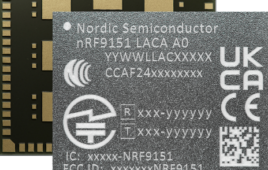This is the third article in a three-part series. The first article examined the driving forces for QoS in wireless networks and the second article outlined the technical requirements of the LTE QoS framework. This article describes how QoS is being implemented in LTE networks using purpose-built System-on-Chip communication processors.
QoS Functions Required in LTE Networks
Described here are the five functions that network elements must have to provide end-to-end QoS in LTE networks.
QoS identification and marking: IP packets belonging to a particular traffic flow are identified and marked through the classification of each packet. This is necessary for coordinating QoS provisions end-to-end throughout the network. Common methods of identifying flows include access control lists and policy-based routing using routing tables. Marking ensures the flow characteristics are carried through portions of, or if necessary, the entire network.
Policing: The policing function is needed to ensure that a flow does not exceed the agreed-upon bit rate. The policing mechanisms also guarantee a minimum share of service to all types of traffic characterized by average/sustained throughput, peak throughput, etc. Non-compliant traffic is either delayed within limits or dropped based on the drop policies. Examples of policing algorithms include single rate two color marker (srTCM) and two rate three color marker (trTCM).
Traffic management and shaping: The traffic management function ensures that bandwidth is available whenever needed to pass mission-critical traffic. It manages the overall bandwidth so that the negotiated bandwidth requirements for different services are all satisfied. For example, it ensures a guaranteed bandwidth for VoIP and control traffic, or a minimum bandwidth for file transfers. Traffic management algorithms, such as weighted random early detection (WRED) and random early detection (RED), are used for congestion monitoring. The shaping function is used for limiting the bandwidth of a flow and avoiding overflow situations.
Administration of QoS policy and management: These functions are realized via provisioning and accounting algorithms in the operations, administration and management domain.
Queuing and scheduling: The scheduling function ensures that important traffic is not dropped in the event of heavy over-subscription. Because IP traffic is usually carried over an Ethernet core in LTE networks, the DiffServ protocol feature of Ethernet is used to provide QoS. The DiffServ standard provides for up to six queues, and the IP traffic is mapped to one of the DiffServ classes, as shown in Figure 7. DiffServ class can also be determined by the Differentiated Services Code Point (DSCP) field in the IP layer in the tunnel header, as shown earlier in Figure 4. Scheduling is based on algorithms like strict priority without starvation avoidance, weighted round robin (WRR), weighted fair queuing (WFQ) and deficit weighted round robin (DWRR), or smoothed deficit weighted round robin (SDWRR).
 Figure 7: DiffServ 6 Class of Services
Figure 7: DiffServ 6 Class of Services
System-on-Chip Implementation of QoS in LTE Networks
Traditionally, complex network functions have been implemented in software using general-purpose processors. This approach is expensive, consumes a considerable amount of power, and may not be able to deliver adequate and deterministic performance under all traffic conditions.
A specialized communication processor that provides hardware acceleration for packet-processing tasks, such as deep-packet inspection (DPI), classification, scheduling and traffic management, affords a more cost-effective and energy-efficient solution for implementing QoS in LTE networks. An example of one such purpose-built System-on-Chip (SoC) platform is the LSI Axxia communication processor. The Axxia architecture, shown in Figure 8, consists of a multicore CPU complex with high-performance PowerPC PPC476FP and ARM® Cortex-A15 processors, and a variety of dedicated, programmable hardware acceleration engines for functions such as DPI, modular packet processor, security and packet modification.
 Figure 8: Axxia Communication Processor Architecture
Figure 8: Axxia Communication Processor Architecture
The traffic management and scheduling functions must accommodate a variety of policing, shaping, scheduling and buffer management algorithms, and Axxia implements these functions using a Virtual Pipeline™ technology that enables flexible packet processing by supporting the simultaneous and arbitrary sequencing of the various acceleration engines. Packet policing, for example, can be implemented with a simple script that uses dual token buckets for metering PIR and CIR rates. Should the bucket fill exceed the peak or sustained rate, incoming packets are marked as being non-conforming.
With SoCs like Axxia, buffer management is implemented in hardware that supports configurable policies, normally via simple scripts. The traffic management engine utilizes hierarchical scheduling, which is necessary to meet the advanced traffic shaping and management requirements of LTE networks. Multiple levels of hierarchy are supported, and each can be configured as a scheduler or a queue for achieving a wide range of QoS granularity. Every level in the hierarchy supports programmable shaping rates and weights, and scheduling algorithms. The traffic manager can also be configured to receive and generate flow control and back pressure signals from and to other engines.
Figure 9 illustrates one implementation of comprehensive QoS for LTE networks in the Axxia traffic manager. In the DiffServ implementation illustrated in the figure, four AF (assured forwarding), one EF (expedited forwarding) and one BE (best effort) queues are arbitrated with DWRR schedulers at various levels in the hierarchy. In addition to the DiffServ queues for data traffic, a separate scheduling hierarchy is implemented with distinct queues for different types of control traffic. Also shown is a separate scheduling hierarchy for WCDMA traffic.
 Figure 9: DiffServ Implementation in Axxia Communication Processor Traffic Manager
Figure 9: DiffServ Implementation in Axxia Communication Processor Traffic Manager
Conclusion
As broadband mobile devices, applications and services proliferate, carrier networks are being required to transport a wider variety of traffic with diverse characteristics. To support these needs, packet-based LTE, with its ability to provide more and more efficient use of bandwidth, is becoming the preferred choice in mobile network infrastructures. Success for network operators is now determined by an ability to deliver multimedia applications and services with a competitive quality of experience for all users. Operators must also deploy innovative service models to maximize ROI and operating margins.
Comprehensive QoS capabilities are essential to addressing these and other challenges. By leveraging the IP QoS concepts and standards like DiffServ, QoS is relatively easy to implement in LTE networks. The implementation of QoS in network elements end-to-end throughout the infrastructure is even easier using purpose-built System-on-Chip communications processors that holistically support the full range of packet processing and traffic management functions, such as packet classification, scheduling, shaping, policing and queue management. And by providing function-specific hardware accelerators capable of delivering peak performance under all circumstances, the SoC also helps maximize utilization of the network infrastructure to deliver peak profitability.




